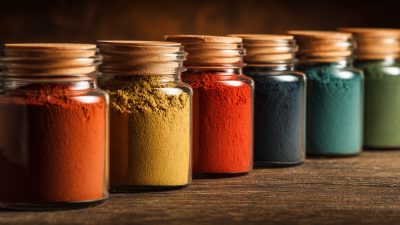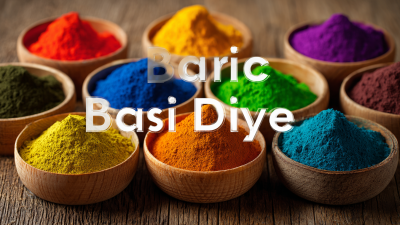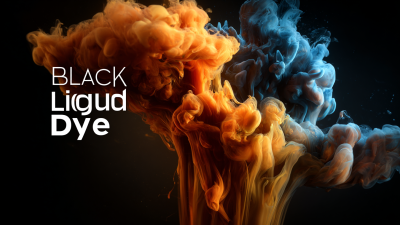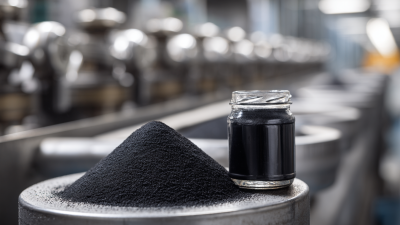The fashion and home decor industries are witnessing a dynamic transformation with the growing popularity of Direct Dyes. As consumers become increasingly conscious of sustainability and environmental impact, the shift towards direct dyeing processes presents a vibrant solution. According to a report by the Textile Exchange, the global market for sustainable textiles is projected to reach $8.25 billion by 2027, with direct dyes offering an eco-friendly alternative that requires less water and produces vibrant, long-lasting colors. Moreover, market analysis from Mordor Intelligence indicates that the direct dyes segment is expected to grow at a significant CAGR, driven by the rising demand for colors that adhere well across diverse fabrics. This exploration delves into the innovative applications and benefits of Direct Dyes in enhancing both fashion and home decor, highlighting their versatility and appeal in today's conscious consumer landscape.

 Direct dyes are a popular choice in the textile industry due to their ease of application and vibrant color retention. These dyes can be directly applied to fabrics, primarily cellulosic fibers like cotton and linen, without the need for a mordant. According to a report by Grand View Research, the global direct dyes market size was valued at approximately $3.5 billion in 2020 and is expected to grow significantly in the coming years as demand for sustainable and colorful fabric options rises. The remarkable wash and lightfastness properties of direct dyes make them suitable for both fashion and home decor, enhancing the aesthetic appeal of textiles while ensuring durability.
Direct dyes are a popular choice in the textile industry due to their ease of application and vibrant color retention. These dyes can be directly applied to fabrics, primarily cellulosic fibers like cotton and linen, without the need for a mordant. According to a report by Grand View Research, the global direct dyes market size was valued at approximately $3.5 billion in 2020 and is expected to grow significantly in the coming years as demand for sustainable and colorful fabric options rises. The remarkable wash and lightfastness properties of direct dyes make them suitable for both fashion and home decor, enhancing the aesthetic appeal of textiles while ensuring durability.
When working with direct dyes, it's essential to follow specific tips to achieve the best results. First, always pre-wash your fabric to remove any residues that might hinder dye absorption. Additionally, consider using fabric softeners post-dyeing to enhance the feel and drape of your textiles. Lastly, always test a small swatch of fabric before committing to a full dye job to understand how the dye interacts with your chosen material.
The environmental impact of dyeing processes is another crucial consideration. Direct dyes are often seen as a more eco-friendly option compared to reactive dyes, primarily because they require less water and energy for application. This characteristic aligns well with the growing trend towards sustainability in the fashion and home decor industries, as consumers increasingly seek out products that minimize environmental harm while providing vibrant, lasting colors.
When selecting direct dyes for fashion and home decor, it's essential to consider several key factors to ensure the best results. First, evaluate the type of material you'll be dyeing. Natural fibers such as cotton, wool, and silk tend to absorb direct dyes better than synthetic materials. This can result in more vibrant colors and longer-lasting effects. Additionally, consider the intended use of the dyed item—furniture or clothing that will be regularly washed may require a dye with better wash-fastness.
**Tips:** Always conduct a test swatch with your chosen dye on a small, inconspicuous area first. This will help you assess the color outcome and the fabric's reaction to the dye. Also, taking note of the color's lightfastness is crucial for items placed in direct sunlight to prevent fading over time.
Another vital factor is color compatibility. When dyeing multiple items, choose a color palette that complements each other. Consider the overall aesthetic of your space or wardrobe. Remember that colors can appear differently based on lighting and surrounding decor, so it's wise to visualize how the dyed pieces fit into the larger picture.
**Tips:** Create a mood board showcasing fabrics, colors, and patterns. This can help refine your vision and guide your choices toward a cohesive look.
This bar chart illustrates the popularity of various direct dyes used in fashion and home decor based on consumer preferences in 2023. The data presented reflects the percentage of users favoring each dye type.
Direct dyes are gaining popularity in both the fashion and home decor industries due to their vibrant colors and versatility. According to a report by Grand View Research, the global textile dye market is expected to reach $5.99 billion by 2027, with direct dyes playing a significant role due to their ease of application and availability in a wide spectrum of shades. This booming demand highlights the importance of mastering application techniques to achieve the best results.
When working with direct dyes, it's essential to follow a step-by-step process. First, prepare the fabric by ensuring it is clean and free of any finishes that could impede the dye's absorption. Pre-soaking the material in a mordant solution may improve the dye’s adherence, especially for cellulose fibers. Once prepared, the dye solution can be applied through various methods such as immersion, spray application, or direct painting, depending on the desired effect. It’s crucial to monitor dyeing times and temperatures carefully, as these factors significantly influence color vibrancy and evenness. A study published in the Journal of Cleaner Production noted that direct dyes, when applied correctly, can achieve a color fastness rating significantly higher than synthetic dyes, making them an attractive option for sustainable fashion and home decor projects.
| Dye Name | Application Method | Suitable Fabrics | Color Fastness | Usage Tips |
|---|---|---|---|---|
| Reactive Yellow 86 | Immersion Dyeing | Cotton, Linen | Very High | Pre-wash for best results |
| Acid Blue 25 | Skein Dyeing | Silk, Nylon | High | Use at lower temperatures |
| Basic Red 1 | Printing | Polyester | Moderate | Combine with mordant for deeper color |
| Direct Blue 86 | Bucket Dyeing | Cotton, Wood | High | Ensure high liquid volume for even dyeing |
| Vat Black 1 | Vat Dyeing | Cotton, Cellulose | Excellent | Follow specific vatting process |
 Direct dyes offer an exciting way to unleash creativity in DIY fashion projects. These vibrant colorants are perfect for adding a personal touch to clothing and accessories, allowing individuals to express their unique style. One fantastic idea is to revamp old denim with a dip-dye technique. By immersing the fabric in a solution of direct dye, you can achieve a stunning gradient effect that transforms a basic pair of jeans into a fashion statement.
Direct dyes offer an exciting way to unleash creativity in DIY fashion projects. These vibrant colorants are perfect for adding a personal touch to clothing and accessories, allowing individuals to express their unique style. One fantastic idea is to revamp old denim with a dip-dye technique. By immersing the fabric in a solution of direct dye, you can achieve a stunning gradient effect that transforms a basic pair of jeans into a fashion statement.
Another innovative application of direct dyes is in fabric painting. With brushes or sponges, you can create intricate designs on various textiles, like t-shirts or tote bags. This method allows for complete artistry—whether you're stenciling geometric patterns or freehanding floral motifs, the possibilities are endless. Direct dyes are also great for mixing colors, enabling you to experiment and create custom shades tailored to your design vision. Through these engaging DIY projects, the world of direct dyes not only invigorates personal wardrobes but also enhances home decor, from cushion covers to table runners, making everyday items truly stand out.
Incorporating direct dyes into home decor can elevate your space with vibrant colors and unique designs. To begin, choose textiles that are compatible with direct dyeing, such as cotton or linen, as they absorb colors more effectively. You can experiment by creating ombre effects on cushions or table runners, allowing colors to fade gradually from deep hues to soft pastels. This technique adds depth and interest to your decor while showcasing your creative flair.
When dyeing items for your home, remember to prepare the materials by washing them thoroughly to remove any finishes that might resist the dye. A well-ventilated space, along with protective gear, is essential to ensure safety during the dyeing process. After dyeing, it is crucial to set the color adequately, often using heat or rinsing agents, to enhance longevity. Consider grouping dyed items in complementary color schemes to create a cohesive look that brightens your room and reflects your personal style.






